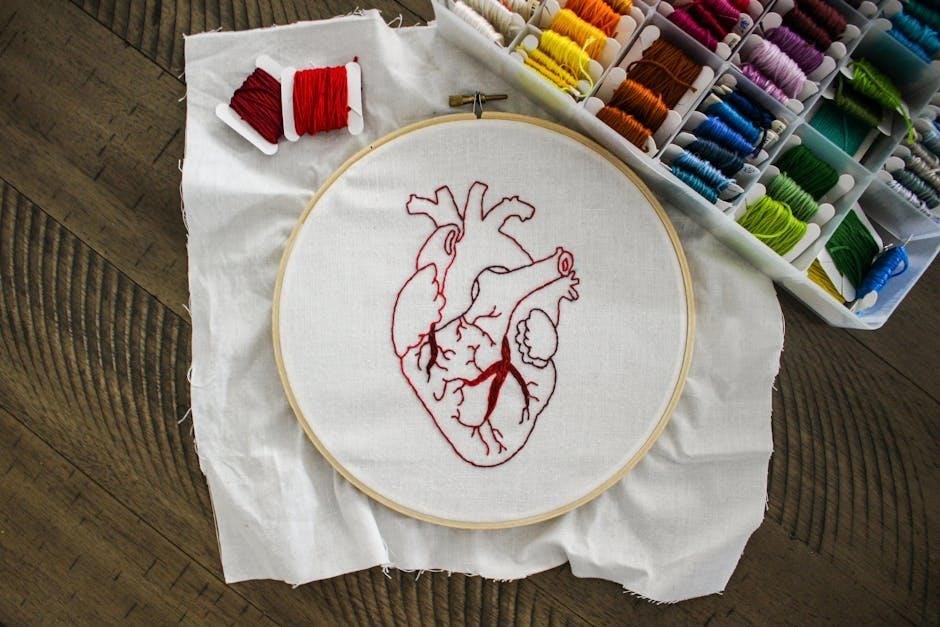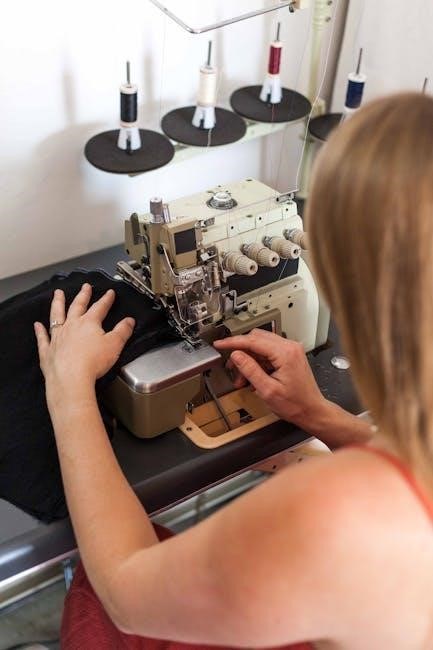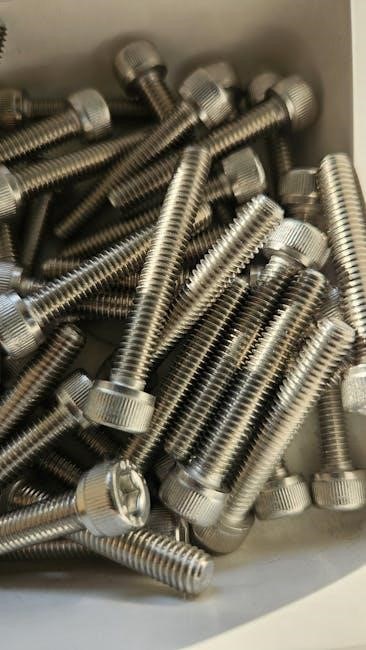Acme screw threads are standardized screw thread forms defined by ANSI/ASME B1.5‚ featuring a trapezoidal profile with a 29-degree angle for power transmission applications.
Definition and Purpose of Acme Screw Threads

Acme screw threads are a type of screw thread defined by the ANSI/ASME B1.5 standard‚ characterized by a trapezoidal thread profile with an included angle of 29 degrees.
Their purpose is to provide a robust and durable screw thread for power transmission and motion control applications‚ offering high load-carrying capacity and resistance to wear.
The trapezoidal shape allows for efficient engagement between the screw and nut‚ minimizing friction and ensuring smooth operation in machinery and mechanical systems.
Acme threads are widely used in applications requiring precise linear motion‚ such as feed screws‚ lead screws‚ and other mechanical actuators.
The standard defines two primary applications: general-purpose threads for power transmission and centralizing threads for alignment and positional accuracy.

History of Acme Screw Thread Standardization
The standardization of Acme screw threads in the United States began in 1932 when Subcommittee No. 4 on Acme Threads of Sectional Committee B1 held its first meeting in New York. A report was presented on the types of Acme threads and the range of sizes and pitches in use. This effort led to the establishment of the ANSI/ASME B1.5 standard‚ which defines the specifications for Acme screw threads. The standard was first published and has since been updated several times‚ with the 1997 edition (ASME B1.5-1997) being a key reference. This standardization ensured uniformity and interchangeability in the manufacture and use of Acme threads across industries‚ promoting consistency in design and application.

Types of Acme Screw Threads
Acme screw threads are categorized into general purpose and centralizing types‚ each designed for specific applications requiring different clearances and precision in power transmission systems.
4.1. General Purpose Acme Threads
General purpose Acme threads are the most commonly used type‚ designed for broad applications requiring reliable power transmission. They are defined by ANSI/ASME B1.5‚ featuring a trapezoidal thread profile with a 29-degree angle. These threads are ideal for applications where high strength and moderate wear resistance are needed. The design includes clearance between the screw and nut‚ allowing for smooth engagement and disengagement. General purpose Acme threads are widely used in machinery‚ jacks‚ and screw actuators. Their versatility makes them suitable for various industries‚ including aerospace and automotive. The standardization ensures consistent dimensions and tolerances‚ enabling interchangeability. Engineers often specify these threads for applications requiring precise control and durability. The trapezoidal shape provides a large contact area‚ enhancing load-carrying capacity and minimizing stress concentrations.
4.2. Centralizing Acme Threads
Centralizing Acme threads are a specialized type designed to ensure proper alignment and minimal radial play between mating components. Unlike general purpose threads‚ centralizing threads have limited clearance at the major diameters of both internal and external threads. This design feature allows them to function as bearing surfaces‚ providing radial support and preventing misalignment. They are extensively used in feed screws‚ lead screws‚ and other applications where precise axial movement and alignment are critical. The limited clearance ensures that the screw and nut remain concentric‚ reducing wear and improving the overall performance of the assembly. Centralizing threads are particularly beneficial in high-precision machinery‚ such as CNC machines and robotic systems‚ where accurate positioning is essential. Their design adheres to the ANSI/ASME B1.5 standard‚ ensuring interchangeability and consistency across applications. This makes them a reliable choice for engineers seeking to maintain tight tolerances and precise control in their designs.
Stub Acme Screw Thread
The Stub Acme screw thread is a specialized thread form developed for unique applications requiring a coarse-pitch thread with shallow depth. Originating in the early 1900s‚ it is used when mechanical or structural constraints demand a thread that balances strength with space efficiency. The Stub Acme thread features a 29-degree included angle‚ similar to standard Acme threads‚ but with a shorter thread height‚ making it ideal for applications where deeper threads are impractical. Its coarse pitch allows for rapid assembly and disassembly‚ while the shallow depth reduces the risk of structural weakness. Despite its niche application‚ the Stub Acme thread adheres to the ASME B1.8 standard‚ ensuring dimensional consistency and interchangeability. It is commonly found in custom machinery and specialized mechanical systems where conventional thread forms are not suitable.

Design Specifications and Classifications
Acme screw threads are classified into general purpose and centralizing types‚ with design specifications outlined in ANSI/ASME B1.5. The standard defines thread form‚ pitch‚ and major diameter‚ ensuring compatibility. Classes of fit (2G‚ 3G‚ 4G) determine tolerance limits‚ affecting assembly and performance. Tighter classes provide precise fits‚ while looser classes allow for easier assembly. Design specifications also cover thread depth‚ lead‚ and angle‚ optimizing for load-carrying capacity and wear resistance. Proper classification ensures threads meet application requirements‚ balancing strength‚ durability‚ and ease of use.

6.1. Thread Form and Dimensions
The Acme screw thread form is trapezoidal‚ with an included angle of 29 degrees perpendicular to the thread axis. The standard specifies the thread dimensions‚ including the major diameter (nominal size)‚ pitch diameter‚ and minor diameter. The pitch is the distance between corresponding points on adjacent threads. For general purpose Acme threads‚ the thread depth is 0.5 times the pitch‚ while centralizing threads have a slightly deeper form to ensure central alignment. The major diameter clearance is critical for proper assembly and load distribution. These dimensions are precisely defined in ANSI/ASME B1.5‚ ensuring compatibility and interchangeability. The thread form and dimensions are optimized for strength‚ wear resistance‚ and ease of manufacturing‚ making them suitable for a wide range of applications requiring precise linear motion control.
6.2. Classes of Fit (2G‚ 3G‚ 4G)
The ANSI/ASME B1.5 standard defines three classes of fit for Acme screw threads: 2G‚ 3G‚ and 4G. Class 2G represents the loosest fit‚ providing maximum clearance between the external and internal threads‚ making it suitable for applications requiring easy assembly and minimal wear. Class 3G offers a medium fit‚ balancing clearance and accuracy‚ ideal for general-purpose applications where moderate precision is needed. Class 4G is the tightest fit‚ designed for applications demanding high precision and minimal backlash‚ often used in high-performance machinery. These classes ensure interchangeability and manufacturability by providing specific tolerances for thread dimensions‚ allowing designers to select the appropriate fit based on the application’s requirements for load‚ wear‚ and operational accuracy.

Applications of Acme Screw Threads
Acme screw threads are widely used in power transmission‚ motion control‚ and as lead screws in machinery‚ providing efficient and durable solutions for linear motion applications.
7.1. General Purpose Applications
Acme screw threads are primarily used in applications requiring precise linear motion and power transmission. They are ideal for general-purpose machinery‚ actuators‚ and lead screws. Their trapezoidal profile ensures high strength and efficiency‚ making them suitable for applications involving heavy loads and rigidity. Common uses include power screws‚ linear actuators‚ and ball screws in industrial machinery. The threads’ ability to handle axial loads effectively makes them a preferred choice for mechanisms requiring consistent and reliable performance. Additionally‚ their self-centering capability enhances stability in operations. These threads are widely adopted in various industries for their durability and ease of manufacturing‚ ensuring optimal functionality in diverse mechanical systems;
7.2. Centralizing Applications
Centralizing Acme screw threads are specifically designed to ensure proper alignment and reduce radial play in mating components. These threads feature limited clearance at the major diameters of both internal and external threads‚ providing a bearing surface that enhances stability. This design is particularly useful in applications such as feed screws‚ where consistent alignment is critical to prevent wear and ensure smooth operation. The restricted clearance allows for better load distribution and minimizes the risk of positional inaccuracies. Centralizing Acme threads are widely used in power transmission systems‚ linear motion devices‚ and machinery requiring precise axial movement. Their ability to maintain proper alignment under load makes them ideal for applications where stability and reliability are paramount.

How to Specify Acme Screw Threads in Engineering Documents
When specifying Acme screw threads in engineering documents‚ it is essential to follow standardized callouts to ensure clarity and accuracy. The specification format typically includes the nominal major diameter‚ threads per inch (TPI)‚ class of fit (e.g.‚ 2G‚ 3G‚ or 4G)‚ and thread type (external or internal). For example‚ a callout might be written as X.XXXX-TPI-NG-ACME-EXTERNAL for screw threads or X.XXXX-TPI-NG-ACME-INTERNAL for nut threads. Here‚ X.XXXX represents the nominal major diameter‚ TPI denotes threads per inch‚ and NG indicates the class of fit. Classes of fit define the tolerance levels‚ with 2G being the loosest and 4G the tightest. Proper specification ensures compatibility and performance in the intended application.

Tolerances and Limits for Acme Screw Threads
Tolerances and limits for Acme screw threads are defined by the ANSI/ASME B1.5 standard to ensure proper fit and function. These specifications outline acceptable dimensional variations for both internal and external threads. The standard classifies fits into three categories: 2G (loose)‚ 3G (medium)‚ and 4G (tight)‚ with 4G providing the closest tolerance. Pitch diameter tolerances are critical‚ as they directly impact the thread’s performance and compatibility. For single-start threads‚ the limits and tolerances are clearly defined‚ while multiple-start threads may require additional considerations. Adherence to these standards ensures that Acme screw threads meet the required precision for their intended applications‚ whether for general purpose or centralizing uses. Proper tolerancing is essential for achieving reliable mechanical performance and manufacturability.

Gaging Practices for Acme Screw Threads
Gaging practices for Acme screw threads are essential for verifying compliance with design specifications. The ANSI/ASME B1.5 standard outlines specific criteria for selecting and using gages. Thread plug gages and ring gages are commonly employed to measure internal and external threads‚ respectively. These gages ensure that the pitch diameter‚ lead‚ and thread angle are within specified limits. Proper gaging involves setting the gage to the minimum or maximum material condition and checking for fit. For internal threads‚ working plug gages are used to verify the go and no-go conditions. Similarly‚ external threads are checked with go and no-go ring gages. Adherence to these practices ensures that Acme screw threads meet precision requirements‚ critical for their performance in power transmission and motion control applications. Regular calibration of gages is also emphasized to maintain accuracy and reliability.

